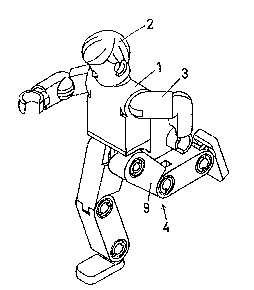Some of the information on this Web page has been provided by external sources. The Government of Canada is not responsible for the accuracy, reliability or currency of the information supplied by external sources. Users wishing to rely upon this information should consult directly with the source of the information. Content provided by external sources is not subject to official languages, privacy and accessibility requirements.
Any discrepancies in the text and image of the Claims and Abstract are due to differing posting times. Text of the Claims and Abstract are posted:
| (12) Patent: | (11) CA 1283541 |
|---|---|
| (21) Application Number: | 1283541 |
| (54) English Title: | TOY FIGURE HAVING MOVABLE BODY PARTS |
| (54) French Title: | FIGURINES-JOUET A MEMBRES MOBILES |
| Status: | Expired and beyond the Period of Reversal |
| (51) International Patent Classification (IPC): |
|
|---|---|
| (72) Inventors : |
|
| (73) Owners : |
|
| (71) Applicants : |
|
| (74) Agent: | SMART & BIGGAR LP |
| (74) Associate agent: | |
| (45) Issued: | 1991-04-30 |
| (22) Filed Date: | 1986-12-03 |
| Availability of licence: | N/A |
| Dedicated to the Public: | N/A |
| (25) Language of filing: | English |
| Patent Cooperation Treaty (PCT): | No |
|---|
| (30) Application Priority Data: | ||||||
|---|---|---|---|---|---|---|
|
Abstract
In a toy figure with body parts movable in various
directions the body parts (in the embodiment shown the
legs) are connected with the body in a manner known per
se by means of a socket (13) designed to receive a ball
(6). To ensure long-term frictional stability between the
movable parts, the body part (9) is formed with a pair
of opposed walls (10, 11) designed to squeeze an engage-
ment face (7) which is contiguous with the ball (6).
Note: Claims are shown in the official language in which they were submitted.
Note: Descriptions are shown in the official language in which they were submitted.

2024-08-01:As part of the Next Generation Patents (NGP) transition, the Canadian Patents Database (CPD) now contains a more detailed Event History, which replicates the Event Log of our new back-office solution.
Please note that "Inactive:" events refers to events no longer in use in our new back-office solution.
For a clearer understanding of the status of the application/patent presented on this page, the site Disclaimer , as well as the definitions for Patent , Event History , Maintenance Fee and Payment History should be consulted.
| Description | Date |
|---|---|
| Inactive: Reversal of expired status | 2012-12-05 |
| Time Limit for Reversal Expired | 2008-04-30 |
| Letter Sent | 2007-04-30 |
| Inactive: IPC from MCD | 2006-03-11 |
| Inactive: Adhoc Request Documented | 1998-04-30 |
| Letter Sent | 1997-04-30 |
| Grant by Issuance | 1991-04-30 |
There is no abandonment history.
| Fee Type | Anniversary Year | Due Date | Paid Date |
|---|---|---|---|
| MF (category 1, 7th anniv.) - standard | 1998-04-30 | 1998-04-07 | |
| MF (category 1, 8th anniv.) - standard | 1999-04-30 | 1999-04-12 | |
| MF (category 1, 9th anniv.) - standard | 2000-05-01 | 2000-03-16 | |
| MF (category 1, 10th anniv.) - standard | 2001-04-30 | 2001-03-16 | |
| MF (category 1, 11th anniv.) - standard | 2002-04-30 | 2002-03-18 | |
| MF (category 1, 12th anniv.) - standard | 2003-04-30 | 2003-03-17 | |
| MF (category 1, 13th anniv.) - standard | 2004-04-30 | 2004-03-17 | |
| MF (category 1, 14th anniv.) - standard | 2005-05-02 | 2005-03-07 | |
| MF (category 1, 15th anniv.) - standard | 2006-05-01 | 2006-03-06 |
Note: Records showing the ownership history in alphabetical order.
| Current Owners on Record |
|---|
| INTERLEGO AG |
| Past Owners on Record |
|---|
| JAN RYAA |
| OLE VESTERGAARD POULSEN |